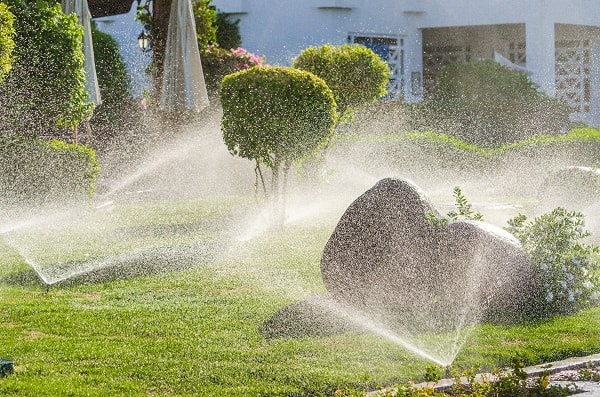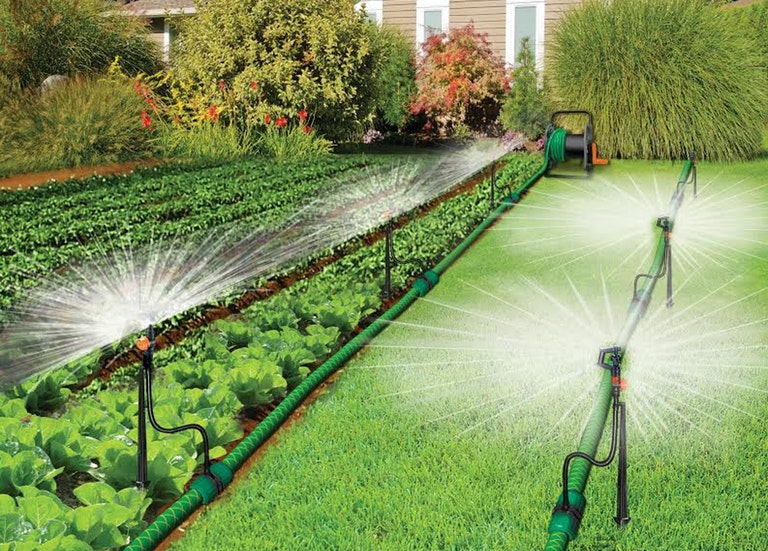Exploring one of the most Typical Troubles in Lawn Sprinkler Equipments and Their Repairs
Lawn sprinkler are essential for maintaining healthy landscapes, yet they commonly experience various troubles. Common issues consist of clogged nozzles, busted pipes, and uneven watering patterns. Each of these can considerably impact system efficiency and water efficiency. Comprehending these troubles and their options is necessary for any kind of property proprietor. The adhering to areas will certainly detail normal challenges and the required repair work to keep a lawn sprinkler operating at its ideal. What comes next may stun those not really prepared for upkeep realities.
Clogged Nozzles and Sprinkler Heads
Stopped up nozzles and lawn sprinkler heads are common problems that can considerably prevent the efficiency of a lawn sprinkler system. In time, particles such as mineral, algae, and dust build-up can gather, obstructing water flow and resulting in irregular protection in the lawn or garden. This can cause certain areas obtaining not enough water, while others may become over-saturated.
Routine upkeep is vital to avoid these clogs. Routine checks can identify any type of blockages, and cleansing can often be completed with simple devices like a little brush or a toothpick. Sometimes, soaking clogged components in vinegar can assist dissolve mineral down payments.
For severe obstructions, substitute of the nozzle or head may be needed to restore correct feature. Dealing with these concerns without delay guarantees that the lawn sprinkler system operates efficiently, enhancing and keeping a healthy and balanced landscape water use.
Broken Pipes and Leaks
Busted pipelines and leakages can significantly interrupt the performance of a lawn sprinkler. Recognizing pipeline damages early is necessary to avoid more issues, and understanding fixing methods can simplify the process. Furthermore, implementing preventative maintenance pointers can assist guarantee the durability of the system and minimize the likelihood of future problems.
Recognizing Pipeline Damage
Exactly how can home owners effectively identify pipeline damages in their sprinkler systems? To start, they need to frequently inspect their yards for unusual damp places or pooling water, which may show a leakage. In addition, homeowners can check their water expenses for inexplicable increases, suggesting surprise leaks within the system. Observing the sprinkler heads for irregular spray patterns or inadequate coverage can also indicate prospective pipeline concerns. Additionally, listening for uncommon sounds, such as hissing or gurgling, might show air running away from damaged pipes. Lastly, carrying out visual evaluations of exposed pipelines for fractures or rust can aid pinpoint problems. By utilizing these approaches, property owners can proactively attend to and identify pipe damage in their sprinkler systems prior to it results in extra substantial issues.
Repair Work Techniques Review
Dealing with pipeline damage in an automatic sprinkler requires a systematic method to repairs, especially when dealing with leakages and breaks. The very first step frequently includes situating the broken location, which can be accomplished via aesthetic inspection or stress testing. As soon as recognized, the repair work technique might differ; for tiny leaks, utilizing pipeline sealer or epoxy can properly seal the damaged area. In cases of substantial breaks, reducing out the harmed pipe segment and changing it with brand-new piping, secured with proper adapters, is suggested. Additionally, making sure proper positioning and protecting joints will certainly aid stop future problems. After repairs, detailed testing of the system is vital to validate that leakages have been solved which the system operates successfully.
Preventative Maintenance Tips
To decrease the threat of busted pipes and leakages in an automatic sprinkler, normal preventative upkeep is essential. Homeowners should routinely evaluate the system for visible damages, making sure that fittings and pipes are undamaged. Seasonal changes are very important; prior to winter season, systems must be drained to stop freezing, while spring checks can determine wear from frost or moving dirt. Additionally, maintaining the area around sprinkler heads free from particles helps avoid blockages that could bring about leaks. On a regular basis testing water stress can expose underlying concerns, as extreme stress might stress pipelines. Finally, documenting upkeep tasks can aid track efficiency and recognize recurring problems, making it much easier to resolve any concerns proactively.
Unequal Watering Patterns
Uneven watering patterns can lead to uneven grass and stressed out plants, originating from different causes such as clogged up nozzles or misaligned lawn sprinkler heads. Determining these concerns is vital for effective repair work and guaranteeing consistent water circulation across the landscape. Solutions might involve simple upkeep jobs or adjustments to the lawn sprinkler for optimal performance.
Reasons For Uneven Watering
When a lawn sprinkler fails to disperse water evenly throughout a lawn, several variables may contribute to this problem. One usual reason is incorrect lawn sprinkler head positioning, which can bring about overlapping or not enough coverage. In addition, blocked nozzles can restrict water flow, causing dry spots. Variants in water stress can also influence distribution, as some locations might obtain a lot more water than others. check here Moreover, unequal terrain or dirt compaction can impact how water penetrates the ground, resulting in irregular absorption. The age of the lawn sprinkler components may result in diminished efficiency, contributing to inconsistent watering patterns. Determining these reasons is essential for preserving a reliable lawn sprinkler system and guaranteeing a healthy and balanced grass.
Solutions for Fixing Issues
Dealing with irregular watering patterns requires a systematic strategy to recognize and remedy underlying issues. Initially, evaluating lawn sprinkler heads for blockages or damage is crucial; cleansing or replacing them can boost water circulation. Next off, adjusting the sprinkler system's pressure settings may assist accomplish a more uniform spray. In addition, examining the layout of the sprinklers can expose areas that require rearranging to guarantee protection uniformity. Inspecting for leaks in pipelines or fittings is essential, as leaks can result in uneven watering. Lastly, configuring the timer to accommodate various areas based on plant demands can boost overall effectiveness. By applying these options, one can successfully restore well balanced watering patterns within the landscape.
Timer and Control Issues
Although a well-functioning timer is vital for peak lawn sprinkler performance, numerous homeowners run into issues that interrupt their watering routines - lawn sprinkler repair. Usual troubles include malfunctioning shows, where timers may not show the designated watering times, causing over- or under-watering. Additionally, power failures can reset timers, triggering them to revert to skip settings and disregarding the tailored schedules homeowners depend on. Breakdowns can also originate from obsolete technology; older timers might lack the features needed for maximum control, such as rain sensing units or clever technology integration. Electrical wiring concerns can stop signals from reaching the valves, providing the system inoperable. Regular maintenance and prompt updates can help reduce these issues. Property owners must take into consideration consulting professionals for fixing to assure their timers operate effectively and efficiently, as proper control is crucial for maintaining a healthy and balanced landscape and conserving water resources
Automatic Sprinkler Pressure Problems
Exactly how can poor water pressure influence a lawn sprinkler's efficiency? Not enough water pressure can result in irregular water distribution, causing dry patches and overwatered locations. This disparity jeopardizes the general health of the landscape, as plants may deal with either dry spell tension or root rot. Reduced pressure can also prevent the operation of lawn sprinkler heads, preventing them from reaching their desired variety and insurance coverage.
 Alternatively, extreme stress can cause damage to the system, leading to leakages or busted elements. Ruptured pipelines and malfunctioning sprinkler heads may take place, sustaining expensive repairs. Determining the origin of stress concerns is vital; common perpetrators include stopped up filters, malfunctioning valves, or even local supply issues. Regular system checks can assist preserve correct stress, guaranteeing a effective and effective automatic sprinkler. Appropriate stress management is essential for peak efficiency and long life of the watering system.
Alternatively, extreme stress can cause damage to the system, leading to leakages or busted elements. Ruptured pipelines and malfunctioning sprinkler heads may take place, sustaining expensive repairs. Determining the origin of stress concerns is vital; common perpetrators include stopped up filters, malfunctioning valves, or even local supply issues. Regular system checks can assist preserve correct stress, guaranteeing a effective and effective automatic sprinkler. Appropriate stress management is essential for peak efficiency and long life of the watering system.Seasonal Maintenance Tips
As the periods change, applying routine maintenance for a lawn sprinkler ends up being crucial to assure peak efficiency and durability. Property owners need to start by checking the system prior to the onset of each period. In the springtime, check for any type of winter damages, clean the nozzles, and readjust the spray patterns to accommodate brand-new growth. Throughout the summer season, confirm that all areas are operating effectively, keeping track of for any kind of dry areas or overwatering. In the autumn, it is necessary to prepare the system for wintertime by draining pipes the lines, burning out the pipes, and protecting any exposed components. A comprehensive examination in the winter can assist recognize potential concerns that could emerge in the spring. Normal upkeep not only extends the life of the lawn sprinkler however likewise promotes a healthy landscape, decreasing water waste and guaranteeing an effective irrigation process throughout the year.

Fixing Usual Sprinkler Issues
What actions should property owners take when encountered with typical sprinkler issues? Initially, they need to observe the system for noticeable indicators of malfunction, such as broken heads or wet areas, showing leaks. Next off, inspecting the timer setups and validating the system is set correctly is vital, as poorly established timers can cause overwatering or underwatering. House owners need to additionally examine the shutoffs for obstructions and verify they close and open properly.
If the system reveals low tide stress, it may be due to a blocked filter or a malfunctioning pump, necessitating comprehensive cleansing. Additionally, house owners must confirm that the watering areas are operating individually and not overlapping, which can drainage. If problems continue, getting in touch with a professional may be essential to diagnose and deal with even more complex problems, verifying the lawn sprinkler operates efficiently and successfully.
Often Asked Concerns
Exactly how Frequently Should I Inspect My Automatic Sprinkler?
A lawn sprinkler need to be examined at the very least two times a year, preferably in spring and fall. Routine checks help determine leaks, clogs, and various other issues, ensuring maximum efficiency and water performance throughout the seasons.
Can I Set Up a Lawn Sprinkler Myself?
Yes, an individual can set up a sprinkler system themselves, offered they have the needed devices, expertise, and abilities. It is a good idea to consult regional guidelines and guidelines to guarantee proper installation and compliance.
What Is the Typical Life Expectancy of an Automatic Sprinkler?
The average lifespan of a sprinkler system typically varies from 10 to 20 years, depending upon the top quality of products, maintenance techniques, and environmental problems, which can considerably impact its longevity and overall efficiency. sprinkler system installation.
Exist Eco-Friendly Options for Lawn Sprinkler Systems?
Green choices for automatic sprinkler consist of drip irrigation, rainfall sensors, and smart controllers. These innovations save water, minimize overflow, and promote efficient watering, making them sustainable options for ecologically conscious homeowners seeking reliable watering options.
Just How Do Weather Influence Lawn Sprinkler Performance?
Weather significantly influence lawn sprinkler efficiency; for circumstances, excessive warmth can bring about evaporation, while hefty rainfall may trigger oversaturation. Additionally, wind can interfere with water circulation, causing inefficient watering and uneven coverage throughout landscapes.
Clogged nozzles and lawn sprinkler heads are usual issues that can significantly prevent the efficiency of a lawn sprinkler system. When a lawn sprinkler system falls short to distribute water evenly across a lawn, numerous factors may add to this issue. A well-functioning timer is critical for peak sprinkler system performance, many homeowners encounter problems that disrupt their watering routines. How can insufficient water stress impact a sprinkler system's effectiveness? Normal system checks can assist keep correct pressure, guaranteeing a reliable and effective lawn sprinkler system.